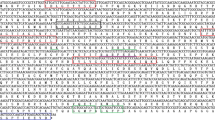Abstract
A cDNA expression library constructed from Culicoides variipennis sonorensis was screened using an antibody specific for Hsp60 of Heliothis virescens. A single clone encoding the complete heat shock protein (Hsp60) of C. variipennis was identified and its 2400-bp insert was sequenced. The encoded 62-kDa protein contains 581 amino acids and includes a 26-amino acid putative mitochondrial targeting sequence at its N terminus and a GGM motif at its carboxyl terminus. Deduced amino acid sequences are highly similar (67–78%) to Hsp60 of other species, including the fruit fly, the house mouse, the Norwegian rat, the Chinese hamster, the human, a nematode, and the tobacco budworm moth. This is the initial isolation of a coding sequence for a stress-induced protein in C. variipennis.
Similar content being viewed by others
REFERENCES
Barettino, G., Morcillo, G., and Diez, J. L. (1989). Induction of the heat-shock response by carbon dioxide in Chironomous thummi. Cell Differ. 23:27.
Bienz, M., and Pelham, H. R. B. (1987). Mechanisms of heat shock gene activation in higher eukaryotes. Adv.Genet. 24:31.
Braig, K., Otwinowski, Z., Hegde, R., Boisvert, D. C., Joachimiak, A., Horwich, A. L., and Sigler, P. B. (1994). The crystal structure of the bacterial chaperonin GroEL at 2.8 Å. Nature 371:578.
Burton, V., Mitchell, H. K., Young, P., and Peterson, N. S. (1988). Heat shock protection against cold stress of Drosophila melanogaster. Mol.Cell Biol. 8:3550.
Chen, C. P., Denlinger, D. L., and Lee, R. E., Jr. (1987). Cold-shock injury and rapid cold hardening in the flesh fly Sarcophaga crassipalpis. Physiol.Zool. 60:297.
Ellis, R. J. (1994) Roles of molecular chaperones in protein folding. Curr.Opin.Struct.Biol. 4:117.
Hartl, F.-U., Hlodan, R., and Langer, T. (1994). Molecular chaperones in protein folding: The art of avoiding sticky situations. Trends Biochem.Sci. 19:20.
Heikkila, J. J. (1993). Heat shock gene expression and development. I. An overview of fungal, plant and poikilothermic animal developmental systems. Dev.Genet. 14:1.
Holbrook, F. R. (1985). Research on the control of bluetongue in livestock by vector suppression. Prog.Clin.Biol.Res. 178:617.
Hunt, J. F., Weaver, A. J., Landry, S. J., Gierasch, L., and Deisenhofer, J. (1996). The crystalstructure of GroES co-chaperonin at 2.8 Å resolution. Nature 379:37.
Jones, R. H. (1967). An overwintering population of Culicoides in Colorado. J.Med.Entomol. 4:461.
Joplin, K. H., and Denlinger, D. L. (1990). Developmental and tissue specific control of the heat shock induced 70 kDa related proteins in the flesh fly, Sarcophaga crassipalpis. J.Insect Physiol. 36:239.
Langer, T., Pfeifer, G., Martin, J., Baumeister, W., and Hartl, F.-U. (1992). Chaperonin-mediated protein folding: GroES binds to one end of the GroEL cylinder, which accommodates the protein substrate within its central cavity. EMBO J. 11:4757.
Lindquist, S. (1986). The heat shock response. Annu.Rev.Biochem. 55:1151.
Miller, S. G., and Leclerc, R. F. (1990). Identification and characterization of a Testis-specific isoform of a chaperonin in a moth, Heliothis virescens. J.Mol.Biol. 214:407.
Mullens, B. A., Tabachnick, W. J., Holbrook, F. R., and Thompson, L. H. (1995). Effects of temperature on virogenesis of bluetongue virus serotype 11 in Culicoides variipennis sonorensis. Med.Vet.Entomol. 9:71.
Netzer, W. J., and Hartl, F. W. (1997). Recombination of protein domains facilitated by cotranslational folding in eukaryotes. Nature 388:343.
Nunamaker, R. A. (1993). Rapid cold-hardening in Culicoides variipennis sonorensis (Diptera: Ceratopogonidae). J.Med.Entomol. 30:913.
Nunamaker, R. A., Sieburth, P. J., Dean, V. C., Wigington, J. G., Nunamaker, C. E., and Mecham, J. O. (1990). Absence of transovarial transmission of bluetongue virus in Culicoides variipennis: Immunogold labeling of bluetongue virus antigen in developing oocytes from Culicoides variipennis (Coquillett). Comp.Biochem.Physiol.A 96:19.
Nunamaker, R. A., Dean, V. C., Murphy, K. E., and Lockwood, J. A. (1996). Stress proteins elicited by cold shock in the biting midge, Culicoides variipennis Wirth and Jones. Comp.Biochem. Physiol. 113B:73.
Peterson, N. S., and Mitchell, H. K. (1985). Heat shock proteins. In Kerkut, G. A., and Gilbert, L. I. (eds.), Comprehensive Insect Physiology, Biochemistry and Pharmacology, Vol. X.Biochemistry, Pergamon Press, Elmsford, NY, pp. 347–366.
Rassow, J., and Pfanner, N. (1996). Chaperones for nascent polypeptides. Curr.Biol. 6:115.
Schatz, G. (1987) 17th Sir Hans Krebs lecture: Signals guiding proteins to their correct locations in mitochondria. Eur.J.Biochem. 165:1.
Tabachnick, W. J. (1992). Genetic differentiation among populations of Culicoides variipennis (Diptera: Ceratopogonidae) the North American vector of Blu virus. Ann.Entomol.Soc.Am. 85:140.
Tabachnick, W. J. (1996). Culicoides variipennis and bluetongue-virus epidemiology in the United States. Annu.Rev.Entomol. 411:23.
Tatem, J., and Stollar, V. (1989). Effect of Sindbis virus infection on the induction of heat shock proteins in Aedes albopictus cells. J.Virol. 63:992.
Todd, M. J., Viitanen, P. V., and Lorimer, G. H. (1994). Dynamics of the chaperonin ATPase cycle implications for facilitated protein folding. Science 265:659.
Author information
Authors and Affiliations
Rights and permissions
About this article
Cite this article
Abdallah, M.A., Pollenz, R.S., Nunamaker, R.A. et al. Identification and Characterization of a cDNA Clone Encoding the Heat Shock Protein (Hsp60) from the Biting Midge, Culicoides variipennis sonorensis Wirth and Jones. Biochem Genet 38, 154–162 (2000). https://doi.org/10.1023/A:1001973529881
Issue Date:
DOI: https://doi.org/10.1023/A:1001973529881




